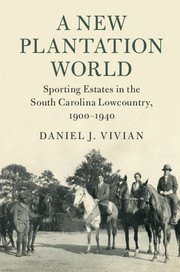'Daniel J. Vivian offers a fascinating, though long forgotten, history of how elite Northerners repurposed the former plantations of the South Carolina Low Country into sporting estates during the early decades of the twentieth century. Well-written and accessible, A New Plantation World complicates our understanding of North-South relations several decades after the Civil War, and demonstrates that the plantations purchased by wealthy Northerners were not intended for mythmaking, but reinvention.'
Karen L. Cox - University of North Carolina, Charlotte, and author of Goat Castle: A True Story of Murder, Race, and the Gothic South
'A New Plantation World peels away layers of myth and romance to reveal the curious story of elite Americans who engaged in conspicuous consumption by refashioning the South Carolina lowcountry, a landscape wrought by slavery, into a leisure playground. Riddled with ironies, this engaging history reminds us that their attempt to transform the region had the effect of perpetuating and intensifying inherited notions of race, region, and cultural privilege associated with this unique American landscape.'
W. Fitzhugh Brundage - University of North Carolina, Chapel Hill
'Daniel J. Vivian deftly and persuasively recuperates the deeply conflicted architectural and cultural histories of the early twentieth-century sporting plantations of the Carolina Low Country. His sharp, insightful engagement with the reinvention of plantation myth and mystique through the interventions of wealthy Northern 'sports' on buildings and landscapes offers a compelling lesson on how wealth, privilege, and politics edit historical and environmental memory.'
Bernard L. Herman - University of North Carolina, Chapel Hill
‘… no one has presented the 'New Plantation World' of the South Carolina lowcountry as comprehensively as Vivian. His book is rich in details and exhaustively footnoted. He draws on a wealth of primary and secondary sources to support his argument, including public and private manuscript collections. Vivian does for the South Carolina lowcountry what Stephanie Yuhl did for the city of Charleston, South Carolina, with A Golden Haze of Memory: The Making of Historic Charleston (2005). Indeed, Yuhl’s and Vivian’s books could serve as companion pieces that present a picture of how the both the urban and rural built environment and landscape of the South Carolina coast were rehabilitated and transformed in the early twentieth century to create an imagined past.’
Jennifer W. Dickey
Source: The American Historical Review



